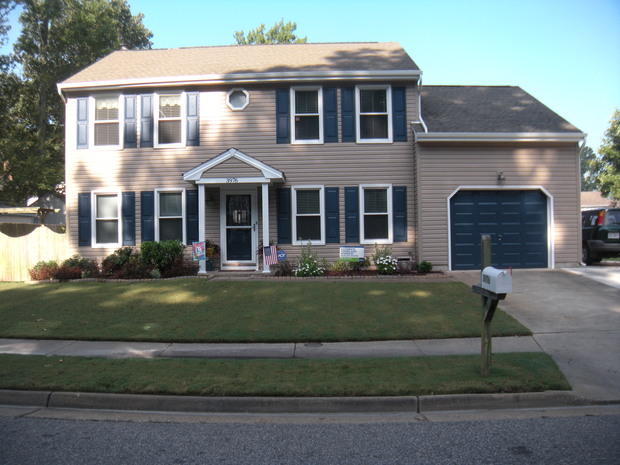
If you’re in the market for new siding but don’t know what to buy, just look around your neighborhood and take a quick survey of everyone’s exterior. Most likely you’ll find overlapping wood materials that seem sturdy and authentic. Or will you? Take a closer look and you may discover a hidden secret: what actually appears to be wood paneling is probably vinyl siding. Even in historic areas, this hard plastic material is by far the most prominent exterior on houses today. Why? Well, not only is it known for its durability and toughness, it’s also quick to install, comes in any style, and is very affordable.
Resilient, Resistant, and On Sale
Vinyl siding is constructed out of a PVC plastic resin, which makes it remarkably strong. Unlike metal or aluminum, it won’t rust, conduct electricity, or dent: even if a baseball hits it, the plastic simply bounces back. And unlike wood, it won’t warp, rot, or chip. It also holds up against the elements since it’s rain, sun, and wind resistant. It won’t wear down in the humidity nor become affected by air pollution. In fact, it’s so long-lasting (it can sometimes retain its physical qualities for up to 40 years) that many times it’ll come with a manufacturer’s guarantee. However, the real benefit of the material is its resistance to sticker shock. Since it’s man made, it’s also one of the cheapest materials around. Plus, unlike aluminum or wood, vinyl siding installation is quick, easy, and undemanding, which also helps to reduce the overall price of the product.
Decorative Decisions
Another benefit of vinyl siding is its overwhelming range of styles, designs, and colors. Since it can be produced in any particular shade, it literally comes in any color to fit your exterior needs. But though it offers all the luxuries of plastic, a vinyl siding installation can still perfectly imitate the appearance of freshly painted wood for true authenticity. Even historic homes have succumbed to its convenience since it can perfectly replicate real wood paneling. It comes in different clapboard widths, horizontal and vertical styles, and even different textures (from smooth to wood grain). It’s also very elastic in order to achieve the right look for your house. Some manufacturers even offer a range of decorative classic mill work that coordinates with their systems, including door and window surrounds, shutters, corner posts, and dental moldings.
Vinyl Siding Maintenance
But what will you have to do to keep it in good shape? Oddly enough, not much. It won’t attract termites or pests. If you hire the right people for the initial vinyl siding installation, it can act as a great insulator to protect your home against extreme temperatures (saving you additional money on energy bills). Also, you’ll never have to paint again. Since the entire product is cast in a certain color, the shade goes all the way through the material. Therefore, it’ll never peel, flake, or scratch like painted surfaces. Not only does this save you on aggravation and sore muscles, it can also save you from hiring a painting crew every few years. It may fade every 5-10 years, but you’ll simply need to buy an occasional replacement panel instead a whole new exterior. But you should clean it once a year (a power washer can help, but a hose does the trick). Also, though the paneling is maintenance-free, the rest of your house may not be: if you have wooden shutters, metal doors, or aluminum trim, you’ll still need to tend to these specific areas of the home.
Common repairs you might come across include:
- Holes: If an impact is strong enough and confined to a small enough area, it is certainly possible to puncture vinyl siding. Repair in this case will depend a lot on the size of the hole. A hole that is very small may be able to be patched with a small cut piece of siding. For larger, more noticeable holes, it is generally recommended that the entire panel the hole is located on be replaced.
- Cracks: Performing work on cold vinyl can actually cause it to crack; even professionals can have a hard time working with vinyl in cold temperatures. If you live in an area that doesn’t see too many freezing temperatures, you might be able to repair vinyl siding almost any time of the year. For those in colder climates, unless it is an emergency, vinyl siding repair should probably wait until the summer.
Ready to start your vinyl siding?
Find ProsThe Drawbacks
First off, it’s durable but not impenetrable. If it is grazed by a lawn mower or snow blower, it will get chewed up and crack. If there are high winds and the paneling isn’t fully secured (usually due to a faulty install), it’ll come off. And when it comes to PVC, there is no patchwork: entire panels will need to be replaced. Also, if not properly installed, it can leak, which then makes it vulnerable to all the elements it is meant to avoid: rot, infestation, and decay (some installers even put weepholes into the underside of the panels to avoid water buildup). Also, PVC paneling appears on 90% of homes in America, which means if you want your house to stand out on its own this isn’t the product for you. However, since it comes in so many different sizes, textures, and colors you have a lot of options to still be different within the same exact medium.
 EIFS vs. Stucco: What Are the Differences?
EIFS vs. Stucco: What Are the Differences?  Stucco Siding – Installation Considerations & Advantages
Stucco Siding – Installation Considerations & Advantages  How to Maintain Different Types of Siding
How to Maintain Different Types of Siding  The Benefits of Cedar Siding
The Benefits of Cedar Siding  Siding Basics
Siding Basics 

Are You Familiar With This Topic? Share Your Experience.